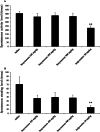Antidepressant-like effects of Sanyuansan in the mouse forced swim test, tail suspension test, and chronic mild stress model
- PMID: 26709221
- PMCID: PMC11916710
- DOI: 10.1016/j.kjms.2015.10.009
Antidepressant-like effects of Sanyuansan in the mouse forced swim test, tail suspension test, and chronic mild stress model
Abstract
Natural products have been widely reported as effective therapeutic alternatives for treatment of depression. Sanyuansan is a compound recipe composed of ginseng total saponins, fish oil, and valeriana. The aims of this study were to validate whether Sanyuansan has antidepressant-like effects through acute behavioral tests including the forced swimming test (FST), tail suspension test (TST), locomotor activity test, and chronic mild stress (CMS) mice model of depression. C57BL/6 mice were given oral administration of 30 mg/kg imipramine, Sanyuansan, and saline, respectively. The acute behavioral tests including the TST, FST, and locomotor activity test were done after the administration of drugs for consecutively three times (24 hours, 1 hour, and 0.5 hour prior to the tests). Furthermore, the sucrose preference and the serum corticosterone level of mice in the CMS model were examined. Sanyuansan only at 900 mg/kg markedly reduced immobility time in the TST compared with the saline-treated group of mice. Sanyuansan at doses of 225 mg/kg, 450 mg/kg, and 900 mg/kg significantly reduced immobility time of mice in the FST. Sanyuansan reversed the CMS-induced anhedonia and hyperactivation of the hypothalamus-pituitary-adrenal axis. In addition, our results showed that neither imipramine nor Sanyuansan at any dosage increased spontaneous motor activity. These results suggested that Sanyuansan induced significant antidepressant-like effects in mice in both acute and chronic animal models, which seemed unlikely to be attributed to an increase in locomotor activities of mice, and had no sedative-like effects.
Keywords: Antidepressant; Chronic mild stress (CMS); Forced swimming test (FST); Sanyuansan; Tail suspension test (TST).
Copyright © 2015. Published by Elsevier Taiwan.
Figures





References
-
- Moussavi S., Chatterji S., Verdes E., Tandon A., Patel V., Ustun B.. Depression, chronic diseases, and decrements in health: results from the World Health Surveys. Lancet. 2007; 370: 851–858. - PubMed
-
- Dilsaver S.C.. An estimate of the minimum economic burden of bipolar I and II disorders in the United States: 2009. J Affect Disord. 2011; 129: 79–83. - PubMed
-
- Belmaker R.H., Agam G.. Major depressive disorder. N Engl J Med. 2008; 358: 55–68. - PubMed
-
- Nestler E.J., Barrot M., DiLeone R.J., Eisch A.J., Gold S.J., Monteggia L.M.. Neurobiology of depression. Neuron. 2002; 34: 13–25. - PubMed
-
- You Z., Luo C., Zhang W., Chen Y., He J., Zhao Q., et al. Pro‐ and anti‐inflammatory cytokines expression in rat's brain and spleen exposed to chronic mild stress: involvement in depression. Behav Brain Res. 2011; 225: 135–141. - PubMed
MeSH terms
Substances
LinkOut - more resources
Full Text Sources
Medical
Miscellaneous

